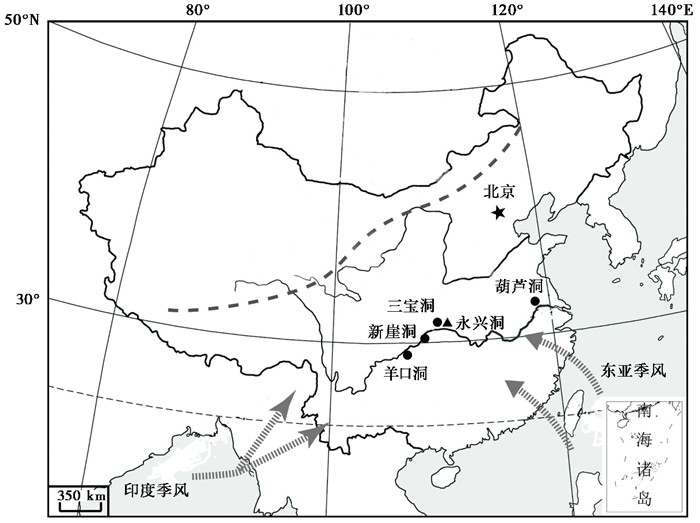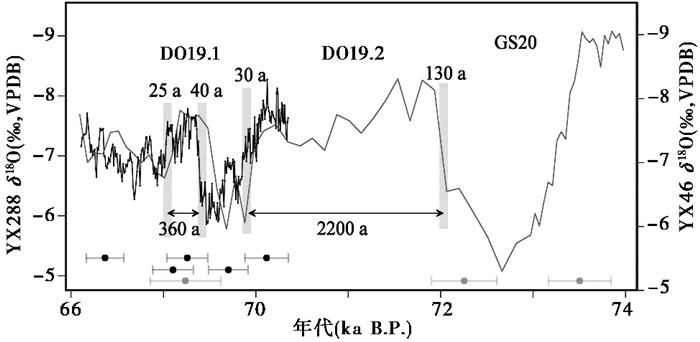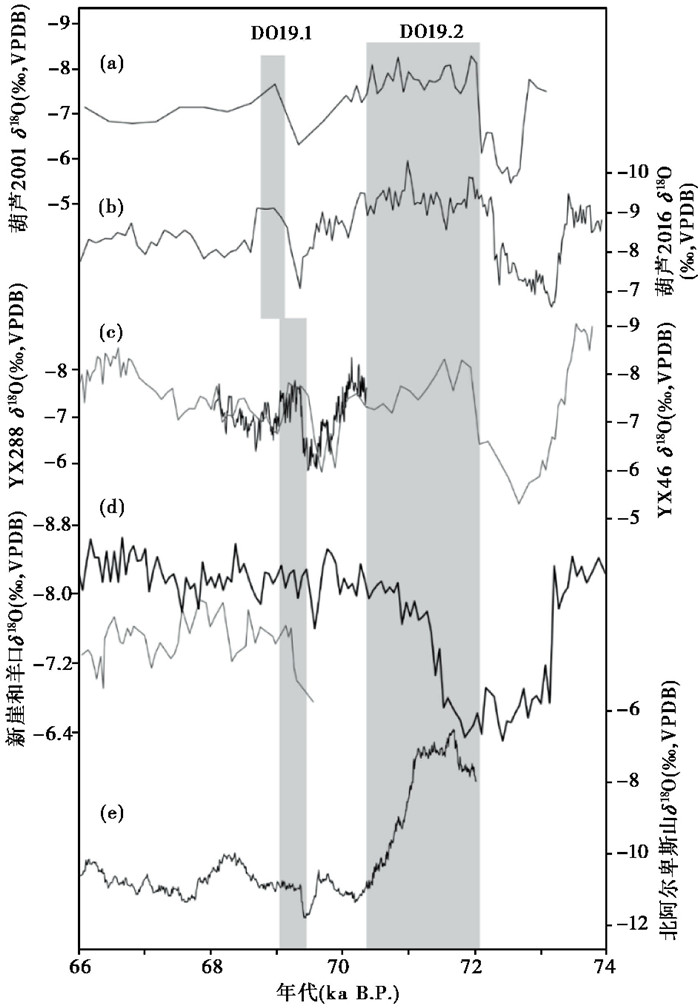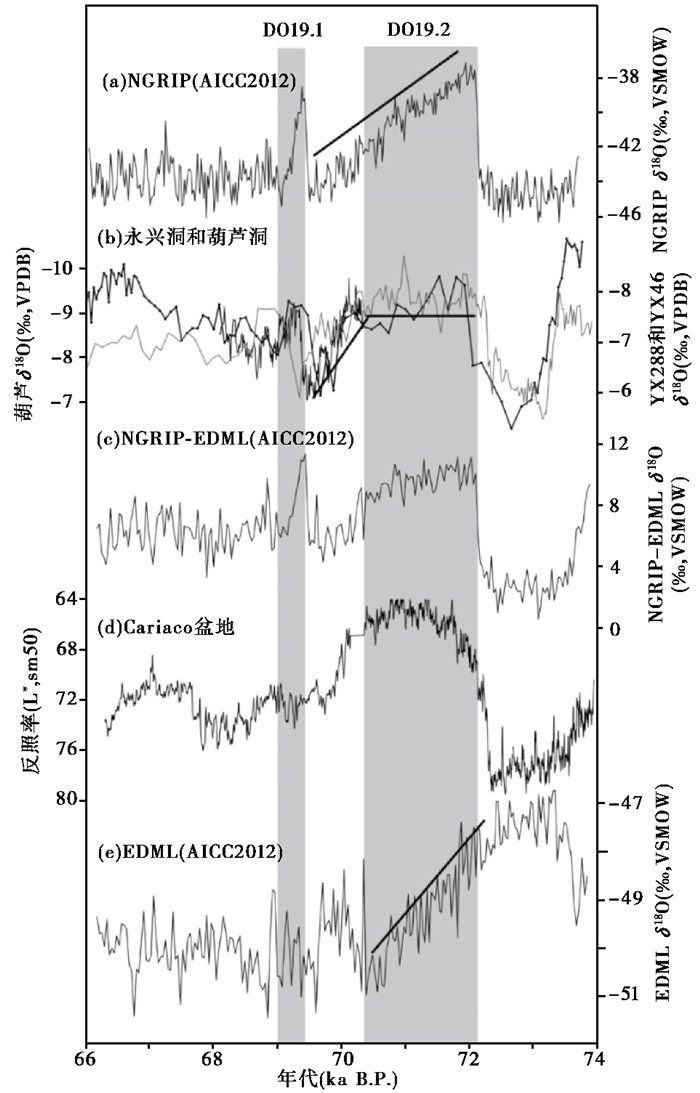2 南京师范大学地理科学学院, 江苏 南京 210023;
3 重庆师范大学地理与旅游学院, 重庆 401331)
千年尺度气候事件是末次冰期气候变化的重要特征。格陵兰冰芯记录显示末次冰期至少发生有25次这样的气候事件[1]。这些事件发生时,格陵兰温度在10~100a内快速上升7~16℃,随后温度缓慢下降,最后又快速降到冰阶。这些事件被称为Dansgaard-Oeschger(简称DO)/Greenland Interstadials(简称GIS)事件[1]。相应的千年尺度事件在南极冰芯中也有所记录[2~4]。在南极冰芯记录中,这些千年尺度事件的变化幅度较小且形态特征也区别于格陵兰记录[4],众多记录显示这些事件的开始和结束过程较缓慢[3~4]。基于大气中CH4、O2等气体浓度变化的等时性,南北两极的千年尺度事件可进行相位对比[2~3]。结果显示,南极增温过程在格陵兰冰阶时就已开始,当南极温度升到最高时,格陵兰开始快速增温[2~3]。但最近一项研究结果显示,南极温度最大值要滞后格陵兰快速增温200余年[5]。南北两极冰芯千年尺度事件相位的不确定性,在很大程度上取决于冰芯时标的精确度。
石笋记录因其高精度定年的特征受到广泛关注。石笋U-Th年代的精确性和准确性有助于校正格陵兰冰芯时标和刻画DO事件的形态特征。在2001年,南京葫芦洞石笋记录显示末次冰期格陵兰冰芯记录的DO事件偏年轻[6]。随后,众多高精度石笋记录对格陵兰DO事件的发生时间进行了校正[7~9]。近年来,GICC05时标[10]大幅度提高了冰芯时标,但是仍然存在很大的不确定性。如贵州大石堡洞和雾露洞石笋对DO4及DO14~17事件[11~12]、山西龙洞石笋对DO8~14和DO25事件[13~14]、重庆羊口洞石笋对DO13~20事件[9, 15~16]以及贵州三星洞石笋对DO22~25事件[17~18]均进行了校正。深海氧同位素4阶段(Marine Isotope Stage 4,简称MIS4)为较为稳定的冰期气候[19],期间仅出现DO19和DO18两次暖事件,而对于DO事件年代的校正多在MIS3阶段,对MIS4阶段的DO18和DO19事件的研究较少。此外,更高分辨的石笋记录能进一步提升对DO事件的校准[20~21]。
东亚石笋同位素记录与南北两极DO事件的形态差异,对理解季风动力学有重要意义。虽然东亚石笋记录与格陵兰记录在千年尺度事件上呈一一对应关系,但是某些事件的形态却存在差异。如云南小白龙洞石笋记录的DO12事件开始过程较为缓慢,区别于格陵兰冰芯记录的快速开始过程[8];南京葫芦洞和北京苦栗树洞石笋记录显示在DO1事件开始后,季风缓慢增强[6, 22],而格陵兰温度在DO1开始发生时快速升温,随后缓慢降温;也有发现表明DO18事件的结束过程在东亚石笋记录中异常缓慢,持续时间长达1500年,而在格陵兰冰芯记录中则在100a内完成[9, 23~24]。那么这些不同于格陵兰记录的事件特征表明东亚气候不仅仅受控于北高纬气候影响,南大洋气候信号在一定程度上也影响着东亚水汽循环[25~26]。还有哪些DO事件的形态特征区别于格陵兰记录,是否与南极记录存在联系,还需进一步验证。
本文利用湖北永兴洞一支高分辨石笋氧同位素记录重建了MIS4阶段DO19.1和DO19.2事件的季风演化过程。该记录清晰的记录了DO19.1持续时间较短的这一气候事件。发现DO19.2气候事件的形态特征显著不同于格陵兰冰芯记录。该研究精确标定了持续时间较短事件DO19.1的开始和结束时间,描绘了冰芯记录中持续时间较长、振荡幅度较大事件DO19.2的详细变化特征。
1 研究区域、材料与方法永兴洞(31°35′N,111°14′E;图 1)位于湖北省神农架保康县歇马镇东10km处,距离神农架三宝洞[27](31°40′N,110°26′E)约80km。神农架地区受西南大巴山弧形山脉东延部分及新华夏断裂褶皱带控制,山地范围辽阔,峰谷相间,平均海拔约2000m。该区域受亚热带季风气候控制,年均温约8℃,年均降水量为1500~2000mm,50 %以上降水集中在夏季6~8月,冬季12~2月降水量较少,仅占全年降水量的5 %。洞穴上覆植被繁盛,以多年生木本植物和灌木丛草本植物为主。洞口海拔约800m,洞长约500m,洞穴封闭性好,洞穴温度每月维持在约14℃,相对湿度接近100 %。YX288石笋外形呈圆柱状,总长264mm,外部直径53~80mm。沿生长轴切开并抛光,发现整体呈黄棕色,上半部较下半部颜色更深且更透明,整体质地致密,仅少部分孔洞发育。

|
图 1 湖北永兴洞与其他洞穴地理位置示意图虚线代表现代亚洲夏季风界限 Fig. 1 Locations of the Yongxing Cave and other sites mentioned in the paper. The modern Asian summer monsoon limit is represented by a dashed line |
在石笋抛光面上,沿着生长轴用直径为0.9mm的牙钻获取5个样品用于230Th定年(单个样品重约40mg)。该测试在南京师范大学同位素质谱实验室完成,测试仪器为MC-ICP-MS Neptune型电离质谱仪,化学实验方法参照Shen等[28]和Shao等[29],年龄误差为±2σ(表 1)。稳定同位素样品的采集使用直径0.5mm的钻头,沿生长中心轴方向每1mm钻取一个样品(约30μg),共获得264组氧碳同位素数据。利用碳酸盐自动进样装置与FinniganMAT-253型质谱仪联机完成测试,分析误差优于±0.05 ‰,VPDB标准,由南京师范大学同位素质谱实验室完成。
2 年代结果及时标建立 2.1 年代时标的建立表 1为YX288石笋的铀钍同位素、实测年代及误差。样品238U含量较高,在857×10-9~1054×10-9g/g之间变化。232 Th含量除样品YX288-225较高外,其余232 Th含量值均较低,在160×10-12~428×10-12g/g之间变化。较高的238U及相对较低232 Th含量,提高了绝对定年的精度,测年误差相对较小,在200~235a之间(相对误差为0.3 %)。5个实测232 Th年代结果显示,YX288石笋发育于MIS4阶段的早期。本文采用MOD-AGE模型建立年龄时标[30](图 2),结果显示该石笋生长于68.10~70.35ka时段。5个实测年代呈直线变化特征,表明该石笋沉积过程较为稳定,平均生长速率较高,约为120μm/a。

|
图 2 MOD-AGE模型建立的YX288石笋年龄模式图 黑点及垂直误差棒分别为实测年龄及对应2σ误差;中间线为年龄模式,两侧线为95 %置信度范围 Fig. 2 Age model of stalagmite YX288 reconstructed by MOD-AGE program. The black dots and vertical bars mark 230Th ages and errors, respectively. The middle solid line and two sides denote the modeled age frame and the corresponding 95 % confidence level |
| 表 1 永兴洞YX288石笋230Th测年结果* Table 1 U-series dating results of stalagmite YX288 in Yongxing Cave |
图 3显示了YX288石笋δ18O随时间的变化过程。δ18O整体上呈现出不对称的“W”型长期变化趋势,在此大趋势上叠加了众多百年-数十年尺度的振荡。YX288 δ18O值在-8.3 ‰ ~-5.9 ‰范围内波动,平均值为-7.1 ‰,平均分辨率约为8.5a。其中,δ18O值在以约69.2ka和70.2ka为中心的两次显著负偏波动(平均值约7.5 ‰),分别对应于格陵兰冰芯氧同位素记录的DO19.1事件及DO19.2事件的晚期;δ18O值在以约68.5ka和69.6ka为中心的两次正偏波动,依次对应于两次DO事件结束后的冰阶期。该数据显示,这两次DO事件的开始和结束过程异常迅速,在数十年内完成。

|
图 3 石笋YX288与同一洞穴YX46的δ18O记录[26]对比 图中灰色条带及上方的数字自右向左依次指示DO19.2和DO19.1事件的开始和结束期及对应的持续时间;双向水平箭头指示两事件的持续时间依次为2200a和360a Fig. 3 Comparison between YX288 and YX46 δ18O records[26]. Grey bands from right to left and the numbers above denote the onsets and terminations of DO19.2 and DO19.1 events and their corresponding durations. The horizontal arrows indicate the durations of the two events are 2200a and 360a, respectively |
石笋同位素分馏平衡是其作为气候指标的前提条件。相对于Hendy检验,石笋同位素之间的重现性被认为是检验同位素平衡分馏的较好选择[31~32]。石笋YX288与该洞YX46石笋δ18O记录[26]在千年及亚千年尺度上显示出高度的一致性(图 3)。此两支石笋δ18O记录除在形态特征上变化一致外,相对变化幅度也较为相似。两条记录的一致性表明石笋YX288氧同位素受动力分馏影响小,主要反映了气候变化信号。尽管东亚石笋δ18O在重建古气候领域得到广泛应用[33~35],但其气候意义尚存在诸多解释[6, 36~41]。石笋δ18O主要继承大气降水氧同位素变化的信号[41],因此石笋δ18O被认为与大气水循环有关。一般认为,石笋δ18O主要反映了夏冬降水比率或夏季降水量的变化[6, 27, 36];也有学者指出,水汽从大洋传输到大陆过程中的分馏程度与降水量的大小密切相关,石笋δ18O反映了从水汽源到沉降地点的综合降水量的变化[37, 42~43]。然而,近来有学者指出,中国石笋δ18O变化主要反映了不同水汽通道氧同位素的变化与降水量或者季风强度关系不大[32]。印度洋的远源水汽传输到中国大陆时分馏作用强导致水汽δ18O值变小,相对来说,太平洋的近源水汽在传输过程中的分馏作用弱导致水汽δ18O相对较大[37~40]。印度洋和太平洋水汽配额主要由ENSO环流以及Hadley与Walker环流间强度变化来控制[44~47]。尽管如此,石笋δ18O记录在不同区域具有良好的重现性,指示了大尺度空间范围的平均季风强度或综合降水量[48]。较低的δ18O值指示季风增强,较高的δ18O值指示季风较弱。
3 讨论 3.1 DO19.1和DO19.2的发生和结束时间YX288石笋δ18O记录清晰的记录了MIS4早期千年尺度事件。发生在约69.20ka和70.20ka的δ18O负偏波动依次对应于DO19.1及DO19.2事件的晚期。与该石笋重现性较好的YX46石笋也清晰的记录到这些事件[26]。DO19.2和DO19.1事件在两支石笋记录中的发生时间依次为约72.06ka和69.40ka,结束时间分别为约69.85ka和69.03ka,持续时间分别约为2200a和360a(图 3)。除永兴洞石笋记录外,这两个事件在南京葫芦洞中均有体现[6, 48]。如图 4所示,早年的葫芦洞记录(2001年)与加密后的高分辨记录(2016年)显示这两次事件分别从约72.30ka和69.20ka开始,结束时间分别为约69.50ka和68.65ka,在测年误差范围内,与永兴洞石笋记录的两次事件的开始和结束时间较为一致。我国西南地区的石笋δ18O记录[9]显示,在DO19.2~19.1期间,石笋δ18O整体负偏,此两事件连在一起。此外,该记录也显示DO19与DO18之间的时段δ18O整体负偏,不同于南京葫芦洞记录的相对偏正特征,显示出此时期西南区域季风整体相对较强的特征,解释为较冷的南极加强了穿赤道气流,同时,较低的海平面(比现今低约80m)引起泰国湾和南中国海大陆架的出露,蒸发减弱以及层云降水量增多,引起水汽及此区域降水δ18O值整体偏低[9]。有学者指出,东亚季风的水汽主要来自于印度季风区[38, 40],如果是这样,那么中国中东部的永兴洞及葫芦洞记录应与西南部的石笋记录一致。因此,我国西南地区与长江中下游地区季风水汽来源构成可能存在差异。高密度定年的北阿尔卑斯山石笋记录校正了冰芯时标,该记录清晰地记录了DO19.2事件,但在事件对应关系上,DO19.1事件并不明显[49]。此外,该记录对于持续较短的DO18事件表现也不显著,格陵兰冰芯记录显示其与DO19.1持续时间均不超过400a。然而这两次持续较短的事件在中国季风区均有清晰的表现[9, 23, 26],表明这些持续时间较短的千年尺度事件的区域差异性及这类事件发生或传输机制的特殊性[49]。

|
图 4 不同洞穴石笋δ18O记录对比 (a)和(b)为南京葫芦洞石笋δ18O[6]和加密后[48]记录;(c)湖北永兴洞YX288(黑色)和YX46石笋(灰色)δ18O记录[26];(d)重庆新崖洞(灰色)[15]和羊口洞石笋δ18O(黑色)记录[9];(e)北阿尔卑斯山石笋δ18O记录[49]灰色阴影部分指示DO19.2和DO19.1事件 Fig. 4 Comparison of different stalagmite δ18O records from multiple caves. (a)and (b) Original and updated Hulu Cave δ18O records in Nanjing Province[6, 48]; (c)δ18O records of stalagmite YX288(this study)and YX46[26] from Yongxing Cave in Hubei Province; (d)Stalagmite δ18O records from Xinya(grey)[15] and Yangkou(black)[9] caves in Chongqing City; (e)Stalagmite δ18O record from the European Alps[49]. The grey shadows indicate DO19.2 and DO19.1 events, respectively |
DO19.2事件在南北两极和亚洲季风区存在区域差异。在格陵兰记录中,DO19.2事件是一个持续时间较长的千年尺度事件[19]。在该事件发生时,格陵兰温度在约75a内快速升温到最高,随后温度缓慢下降至冰阶水平,未发生有典型DO事件的快速结束过程,该事件大致呈直角三角状[19]。在亚洲季风区,永兴洞记录显示出与格陵兰不相同的事件特征。在该事件发生时,东亚季风快速增强,此后维持在这一水平约1700a,之后不同于格陵兰温度缓慢下降的特征[19],东亚季风强度在约30a内快速减弱。该事件的结构特征也得到南京葫芦洞记录的支持[6, 48](图 5)。以往研究显示,亚洲季风与格陵兰温度在发生频率和事件特征上有很好的一致性[11, 50],但是,也报道有微小差异,如YD和DO12事件的开始过程都显著缓慢于格陵兰温度变化[22, 51],而DO19.2事件的结束过程相对于格陵兰温度变化较快,而不是以往研究的缓慢变化。这种差异表明东亚季风除受北高纬温度变化的影响外,还受到其他气候因子的控制,如南半球温度变化对季风动力变化有重要影响[25~26]。

|
图 5 YX288石笋δ18O记录与其他高低纬地区洞穴石笋记录对比 (a)和(e)分别为格陵兰NGRIP和南极EDML(AICC2012)冰芯δ18O记录[10];(b)永兴洞和葫芦洞[6, 48]石笋δ18O记录;(c)NGRIP与EDML冰芯δ18O记录之差(AICC2012);(d)Cariaco盆地反照率(L*)记录[58],sm50代表 50点平滑灰色阴影部分指示DO19.2和DO19.1事件;水平与倾斜直线指示δ18O变化过程 Fig. 5 Comparison of YX288δ18O record with other records from high and low latitudes. (a)and (e) NGRIP and EDML δ18O records at the AICC 2012 timescale[10]; (b)Stalagmite δ18O records from Yongxing and Hulu Caves[6, 48]; (c)The difference of δ18O records between NGRIP and EDML ice cores; (d)Reflectance (L*) from Cariaco Basin sediment[58] and sm50 represents 50-point running mean; The grey shadows indicate DO19.2 and DO19.1 events, respectively. The lines indicate the long-term trends of δ18O records |
东亚季风受南北两极气候共同影响。北高纬千年尺度事件通过影响蒙古-西伯利亚高压,借助西风带把DO事件的气候信息传输到东亚地区[52~53]。北高纬升温导致欧亚大陆温度升高,有利于季风环流的增强。南高纬气候信号通过穿赤道气流进入东亚,进而影响东亚季风的强度[25, 54~55]。增强的穿赤道气流促使东亚季风增强。为了进一步研究南极温度变化对DO19.2事件的影响,将南极温度[10]与石笋δ18O记录进行对比。图 5显示,在AICC2012时标下,高分辨率的EDML冰芯记录的温度变化与格陵兰温度在GS20冰阶呈反相位变化;在DO19.2期间,南北两极温度都呈下降趋势,支持MIS3阶段的两极see-saw机制[56]。为了评估南北两极温度下降过程对亚洲季风作用过程相反的综合影响。我们将NGRIP和EDML冰芯在AICC2012时标[10]下进行35a等间距内插,相减后得到南北两极的温度梯度(图 5c)。这一温度梯度在间冰阶和冰阶期分别增大和降低,意味着DO事件发生时北大西洋温盐环流增强,在冰阶时减弱,这与反映温盐环流强度变化的海洋沉积物Pa/Th记录相一致[57]。这一温度梯度记录与东亚石笋记录有很好的相似性,都清晰的呈现出DO19.2和DO19.1事件。此外,该温度梯度记录还显示在DO19.2事件开始和结束过程分别快速升高和降低;在DO19.2事件期间,南北两极温度梯度几乎稳定不变。这一温度梯度记录与石笋记录的一致性表明南北两极对亚洲季风千年尺度的共同影响作用。Cariaco盆地反照率记录变化指示了热带辐合带(Intertropical Convergence Zone,简称ITCZ)的南北变化[58],此变化主要响应于南北半球的温度梯度变化[59~60]。图 5显示,Cariaco盆地反照率变化和格陵兰与南极的温度梯度记录有很好的相似性,进一步支持南北温度变化对亚洲季风的综合影响。南北两极温度差在DO19.2事件期间的稳定性表明,在该事件期间南北两极温度下降的速度一致,暗示了南北两极气候系统变化步调的紧密性。
4 结论本文基于湖北永兴洞YX288石笋5个高精度U-Th定年和高分辨的氧同位素数据,重建了MIS4早期东亚夏季风水文循环演化过程。YX288石笋δ18O记录显示出不对称的“W”型特征,两次季风增强期分别对应于DO19.1事件及DO19.2事件的晚期,期间的弱季风期对应于GS19.2冰阶期。这些特征与同一洞穴YX46记录的波动特征高度一致,共同指示了MIS4早期东亚季风经历了2次显著的季风增强期。永兴洞石笋清晰的记录了DO19.1和DO19.2事件以及GS19.2和GS20冰阶。记录显示DO19.2和DO19.1事件分别开始于约72.06ka和69.40ka,结束时间约为69.85ka和69.03ka,在误差范围内与格陵兰NGRIP冰芯AICC2012时标记录的两事件的发生时间(约72.14ka和69.46ka)和结束时间(DO19.2不显著;DO19.1约为69.25ka)较为一致,支持AICC2012时标。两事件的持续时间依次约为2200a和360a。尽管季风区表现出类似于格陵兰冰芯记录的千年尺度事件,但是在形态特征上高低纬气候存在差异。在DO19.2事件期间,石笋记录的东亚季风较为稳定,不同于格陵兰冰芯记录的持续降温变化。这一季风较为稳定的特征与南北两极间温度差在此时期稳定波动的特征较为一致。此外,主要受控于南北半球温梯度变化的热带辐合带位置的变化也支持此时期ITCZ稳定在较北位置,这些证据表明南北半球的温度变化共同对亚洲季风产生影响。
致谢: 感谢审稿专家与编辑部杨美芳老师对本文提出宝贵的修改意见。
| [1] |
Wolff E W, Chappellaz J, Blunier T, et al. Millennial-scale variability during the last glacial:The ice core record[J]. Quaternary Science Reviews, 2010, 29(21-22): 2828-2838. DOI:10.1016/j.quascirev.2009.10.013 |
| [2] |
Blunier T, Brook E J. Timing of millennial-scale climate change in Antarctica and Greenland during the last glacial period[J]. Science, 2001, 291(5501): 109-112. DOI:10.1126/science.291.5501.109 |
| [3] |
EPICA Community Members. One-to-one coupling of glacial climate variability in Greenland and Antarctica[J]. Nature, 2006, 444(7116): 195-198. DOI:10.1038/nature05301 |
| [4] |
Jouzel J, Masson-Delmotte V, Cattani O, et al. Orbital and millennial Antarctic climate variability over the past 800, 000 years[J]. Science, 2007, 317(5839): 793-796. DOI:10.1126/science.1141038 |
| [5] |
WAIS Divide Project Members. Precise interpolar phasing of abrupt climate change during the last ice age[J]. Nature, 2015, 520(7549): 661-665. DOI:10.1038/nature14401 |
| [6] |
Wang Y J, Cheng H, Edwards R L, et al. A high-resolution absolute-dated Late Pleistocene monsoon record from Hulu Cave, China[J]. Science, 2001, 294(5550): 2345-2348. DOI:10.1126/science.1064618 |
| [7] |
Burns S J, Fleitmann D, Matter A, et al. Indian Ocean climate and an absolute chronology over Dansgaard/Oeschger events 9 to 13[J]. Science, 2003, 301(5638): 1365-1367. DOI:10.1126/science.1086227 |
| [8] |
Cai Y J, An Z S, Cheng H, et al. High-resolution absolute-dated Indian Monsoon record between 53 and 36 ka from Xiaobailong Cave, south-western China[J]. Geology, 2006, 34(8): 621-624. DOI:10.1130/G22567.1 |
| [9] |
Zhang T T, Li T Y, Cheng H, et al. Stalagmite-inferred centennial variability of the Asian summer monsoon in southwest China between 58 and 79 ka BP[J]. Quaternary Science Reviews, 2017, 160: 1-12. DOI:10.1016/j.quascirev.2017.02.003 |
| [10] |
Veres D, Bazin L, Landais A, et al. The Antarctic ice core chronology(AICC2012):An optimized multi-parameter and multi-site dating approach for the last 120 thousand years[J]. Climate of the Past, 2013, 9(4): 1733-1748. DOI:10.5194/cp-9-1733-2013 |
| [11] |
Liu D B, Wang Y J, Cheng H, et al. Sub-millennial variability of Asian monsoon intensity during the early MIS3 and its analogue to the ice age terminations[J]. Quaternary Science Reviews, 2010, 29(9-10): 1107-1115. DOI:10.1016/j.quascirev.2010.01.008 |
| [12] |
Zhao K, Wang Y J, Edwards R L, et al. High-resolution stalagmite δ18O records of Asian monsoon changes in central and southern China spanning the MIS3/2 transition[J]. Earth and Planetary Science Letters, 2010, 298(1-2): 191-198. DOI:10.1016/j.epsl.2010.07.041 |
| [13] |
董进国, 赵侃, 沈川洲, 等. 黄土高原石笋记录的DO25季风增强事件[J]. 第四纪研究, 2016, 36(6): 1502-1509. Dong Jinguo, Zhao Kan, Shen Chuan-Chou, et al. Strong East Asian summer monsoon during the DO25 event recorded by an absoluted-dated stalagmite from Dragon Cave, Northern China[J]. Quaternary Sciences, 2016, 36(6): 1502-1509. |
| [14] |
Dong J G, Shen C C, Kong X G, et al. Asian monsoon dynamics at Dansgaard/Oeschger events 14-8 and Heinrich events 5-4 in Northern China[J]. Quaternary Geochronology, 2018, 47: 72-80. DOI:10.1016/j.quageo.2018.05.012 |
| [15] |
Li T Y, Yuan D X, Li H C, et al. High-resolution climate variability of Southwest China during 57-70 ka reflected in a stalagmite δ18O record from Xinya Cave[J]. Science in China(Series D), 2007, 50(8): 1202-1208. DOI:10.1007/s11430-007-0059-z |
| [16] |
Li T Y, Han L Y, Cheng H, et al. Evolution of the Asian summer monsoon during Dansgaard/Oeschger events 13-17 recorded in a stalagmite constrained by high-precision chronology from Southwest China[J]. Quaternary Research, 2017, 88(1): 121-128. |
| [17] |
王晓艳, 何尧启, 姜修洋. CIS 24事件的精确定年及亚旋回特征:以黔北三星洞石笋为例[J]. 第四纪研究, 2015, 35(6): 1418-1424. Wang Xiaoyan, He Yaoqi, Jiang Xiuyang. Precise dating of the Chinese-Interstadial 24 event and its sub-cycles inferred from a high resolution stalagmite δ18O record in northern Guizhou Province[J]. Quaternary Sciences, 2015, 35(6): 1418-1424. |
| [18] |
Jiang X Y, Wang X Y, He Y Q, et al. Precisely dated multidecadally resolved Asian summer monsoon dynamics 113.5-86.6 thousand years ago[J]. Quaternary Science Reviews, 2016, 143: 1-12. DOI:10.1016/j.quascirev.2016.05.003 |
| [19] |
Rasmussen S O, Bigler M, Blockley S P, et al. A stratigraphic framework for abrupt climatic changes during the Last Glacial period based on three synchronized Greenland ice-core records:Refining and extending the INTIMATE event stratigraphy[J]. Quaternary Science Reviews, 2014, 106: 14-28. DOI:10.1016/j.quascirev.2014.09.007 |
| [20] |
赵侃, 孔兴功, 程海, 等. MIS3晚期东亚季风强度和DO事件年龄[J]. 第四纪研究, 2008, 28(1): 177-183. Zhao Kan, Kong Xinggong, Cheng Hai, et al. Intensity and timing of D-O events of East Asian monsoon during the late episode of MIS3[J]. Quaternary Sciences, 2008, 28(1): 177-183. DOI:10.3321/j.issn:1001-7410.2008.01.020 |
| [21] |
刘殿兵, 汪永进, 陈仕涛, 等. 东亚季风MIS3早期DO事件的亚旋回及全球意义[J]. 第四纪研究, 2008, 28(1): 169-176. Liu Dianbing, Wang Yongjin, Chen Shitao, et al. Sub-Dansgaard-Oeschger events of East Asian monsoon and their global significance[J]. Quaternary Sciences, 2008, 28(1): 169-176. DOI:10.3321/j.issn:1001-7410.2008.01.019 |
| [22] |
Ma Z B, Cheng H, Tan M, et al. Timing and structure of the Younger Dryas event in Northern China[J]. Quaternary Science Reviews, 2012, 41: 83-93. DOI:10.1016/j.quascirev.2012.03.006 |
| [23] |
张伟宏, 廖泽波, 陈仕涛, 等. 湖北高分辨率石笋记录的DO18事件特征[J]. 沉积学报, 2018, 36(4): 674-683. Zhang Weihong, Liao Zhebo, Chen Shitao, et al. DO18 event depicted by a high-resolution stalagmite record from Yongxing Cave, Hubei Province[J]. Acta Sedimentologica Sinica, 2018, 36(4): 674-683. |
| [24] |
孙喜利, 杨勋林, 史志超, 等. 石笋记录的西南地区MIS4阶段夏季风的演化[J]. 第四纪研究, 2017, 37(6): 1370-1380. Sun Xili, Yang Xunlin, Shi Zhichao, et al. The evolution of summer monsoon in Southwest China during MIS4 as revealed by stalagmite δ18O record[J]. Quaternary Sciences, 2017, 37(6): 1370-1380. |
| [25] |
Rohling E J, Liu Q S, Roberts A P, et al. Controls on the East Asian monsoon during the last glacial cycle, based on comparison between Hulu Cave and polar ice-core records[J]. Quaternary Science Reviews, 2009, 28(27-28): 3291-3302. DOI:10.1016/j.quascirev.2009.09.007 |
| [26] |
Chen S T, Wang Y J, Cheng H, et al. Strong coupling of Asian monsoon and Antarctic climates on sub-orbital timescales[J]. Scientific Reports, 2016, 6(1): 32995. DOI:10.1038/srep32995 |
| [27] |
Wang Y J, Cheng H, Edwards R L, et al. Millennial-and orbital-scale changes in the East Asian monsoon over the past 224, 000 years[J]. Nature, 2008, 7182(451): 1090-1093. |
| [28] |
Shen C C, Edwards R L, Cheng H, et al. Uranium and thorium isotopic concentration measurements by magnetic sector inductively coupled plasma massspectrometry[J]. Chemical Geology, 2002, 185(3): 165-178. |
| [29] |
Shao Q F, Bahain J J, Wang W, et al. Coupled ESR and U-series dating of Early Pleistocene Gigantopithecus faunas at Mohui and Sanhe caves, Guangxi, Southern China[J]. Quaternary Geochronology, 2015, 30(B): 524-528. |
| [30] |
Hercman H, Pawlak J. MOD-AGE:An age-depth model construction algorithm[J]. Quaternary Geochronology, 2012, 12(12): 1-10. |
| [31] |
Doral J A, Liu Z H. Limitations of Hendy test criteria in judging the paleoclimatic suitability of speleothems and the need for replication[J]. Journal of Cave and Karst Studies, 2009, 71(1): 73-80. |
| [32] |
程海, 艾思本, 王先锋, 等. 中国南方石笋氧同位素记录的重要意义[J]. 第四纪研究, 2005, 25(2): 157-163. Cheng Hai, Edwards R L, Wang Xianfeng, et al. Oxygen isotope records of stalagmites from Southern China[J]. Quaternary Sciences, 2005, 25(2): 157-163. DOI:10.3321/j.issn:1001-7410.2005.02.004 |
| [33] |
崔梦月, 洪晖, 孙晓双, 等. 福建仙云洞石笋记录的新仙女木突变事件结束时的缓变特征[J]. 第四纪研究, 2018, 38(3): 711-719. Cui Mengyue, Hong Hui, Sun Xiaoshuang, et al. The gradual change characteristics at the end of the Younger Dryas event inferred from a speleothem record from Xianyun Cave, Fujian Province[J]. Quaternary Sciences, 2018, 38(3): 711-719. |
| [34] |
张伟宏, 陈仕涛, 汪永进, 等. 小冰期东亚夏季风快速变化特征:湖北石笋记录[J]. 第四纪研究, 2019, 39(3): 765-774. Zhang Weihong, Chen Shitao, Wang Yongjin, et al. Rapid change in the East Asian summer monsoon:Stalagmite records in Hubei, China[J]. Quaternary Sciences, 2019, 39(3): 765-774. |
| [35] |
薛刚, 蔡演军, 马乐, 等. 山东半岛石笋记录的倒数第二次冰消期δ18O变化特征及其气候环境意义[J]. 第四纪研究, 2019, 39(4): 812-824. Xue Gang, Cai Yanjun, Ma Le, et al. The penultimate deglaciation characters and significance of climatic and environmental changes in Shandong Peninsula, inferred from speleothem δ18O records[J]. Quaternary Sciences, 2019, 39(4): 812-824. |
| [36] |
Zhang P Z, Cheng H, Edwards R L, et al. A test of climate, sun, and culture relationships from an 1810-year Chinese cave record[J]. Science, 2008, 322(5903): 940-942. DOI:10.1126/science.1163965 |
| [37] |
Yuan D X, Cheng H, Edwards R L, et al. Timing, duration, and transitions of the last interglacial Asian monsoon[J]. Science, 2004, 304(5670): 575-578. DOI:10.1126/science.1091220 |
| [38] |
Maher B A, Thompson R. Oxygen isotopes from Chinese caves:records not of monsoon rainfall but of circulation regime[J]. Journal of Quaternary Sciences, 2012, 27(6): 615-624. DOI:10.1002/jqs.2553 |
| [39] |
Clemens S C, Prell W L, Sun Y B. Oribital-scale timing and mechanisms driving Late Pleistocene Indo-Asian summer monsoons:Reinterpreting cave speleothem δ18O[J]. Paleoceanography, 2010, 25(4): PA4207. DOI:10.1029/2010PA001926 |
| [40] |
Pausata F S, Battisti D S, Nisancioglu K H, et al. Chinese stalagmite δ18O controlled by changes in the Indian monsoon during a simulated Heinrich event[J]. Nature Geoscience, 2011, 4(7): 474-480. DOI:10.1038/ngeo1169 |
| [41] |
张键, 李廷勇. "雨量效应"与"环流效应":近1 ka亚澳季风区石笋和大气降水δ18O的气候意义[J]. 第四纪研究, 2018, 38(6): 1532-1544. Zhang Jian, Li Tingyong. "Amount effect" vs."Circulation effect":The climate significance of precipitation and stalagmite δ18O in the Asian-Australian monsoon region over the past 1 ka[J]. Quaternary Sciences, 2018, 38(6): 1532-1544. |
| [42] |
Hu C Y, Henderson G M, Huang J H, et al. Quantification of Holocene Asian monsoon rainfall from spatially separated cave records[J]. Earth and Planetary Science Letters, 2008, 266(3-4): 221-232. DOI:10.1016/j.epsl.2007.10.015 |
| [43] |
王健, 程海, 赵景耀, 等. 小冰期多尺度气候波动:贵州董哥洞高分辨率石笋记录[J]. 第四纪研究, 2019, 39(3): 775-785. Wang Jian, Cheng Hai, Zhao Jingyao, et al. Climate variability during the Little Ice Age characterized by a high-resolution stalagmite record from Dongge Cave, Guizhou[J]. Quaternary Sciences, 2019, 39(3): 775-785. |
| [44] |
谭明. 环流效应:中国季风区石笋氧同位素短尺度变化的气候意义——古气候记录与现代气候研究的一次对话[J]. 第四纪研究, 2009, 29(5): 851-862. Tan Ming. Circulation effect:Climatic significance of the short term variability of the oxygen isotopes in stalagmites from monsoonal China[J]. Quaternary Sciences, 2009, 29(5): 851-862. DOI:10.3969/j.issn.1001-7410.2009.05.01 |
| [45] |
谭明, 南素兰. 中国季风区降水氧同位素年际变化的"环流效应"初探[J]. 第四纪研究, 2010, 30(3): 620-622. Tan Ming, Nan Sulan. Primary investigation on interannual changes in circulation effect of precipitation oxygen isotopes in monsoon China[J]. Quaternary Sciences, 2010, 30(3): 620-622. DOI:10.3969/j.issn.1001-7410.2010.03.21 |
| [46] |
谭明, 南素兰, 段武辉. 中国季风区大气降水同位素的季节尺度环流效应[J]. 第四纪研究, 2016, 36(3): 575-580. Tan Ming, Nan Sulan, Duan Wuhui. Seasonal scale circulation effect of stable isotope in atmospheric precipitation in the monsoon regions of China[J]. Quaternary Sciences, 2016, 36(3): 575-580. |
| [47] |
Beck J W, Zhou W, Li C, et al. A 550, 000-year record of East Asian monsoon rainfall from 10Be in loess[J]. Science, 2018, 360(6391): 877-881. DOI:10.1126/science.aam5825 |
| [48] |
Cheng H, Edwards R L, Sinha A, et al. The Asian monsoon over the past 640, 000 years and ice age terminations[J]. Nature, 2016, 534(7609): 640-646. DOI:10.1038/nature18591 |
| [49] |
Boch R, Cheng H, Spötl C, et al. NALPS:A precisely dated European climate record 120-60 ka[J]. Climate of the Past, 2011, 7(4): 1247-1259. DOI:10.5194/cp-7-1247-2011 |
| [50] |
Duan W H, Cheng H, Tan M, et al. Onset and duration of transitions into Greenland Interstadials 15[J]. Scientific Reports, 2016, 6(1): 20844. DOI:10.1038/srep20844 |
| [51] |
Liu D B, Wang Y J, Cheng H, et al. A detailed comparison of Asian monsoon intensity and Greenland temperature during the Allerød and Younger Dryas events[J]. Earth and Planetary Science Letters, 2008, 272(3-4): 691-697. DOI:10.1016/j.epsl.2008.06.008 |
| [52] |
Porter S C, An Z S. Correlation between climate events in the North Atlantic and China during the last glaciation[J]. Nature, 1995, 375(6529): 305-308. DOI:10.1038/375305a0 |
| [53] |
Sun Y B, Clemens S C, Morrill C, et al. Influence of Atlantic meridional overturning circulation on the East Asian winter monsoon[J]. Nature Geoscience, 2011, 5(1): 46-49. |
| [54] |
An Z S. The history and variability of the East Asian paleomonsoon climate[J]. Quaternary Science Reviews, 2000, 19(1-5): 171-187. DOI:10.1016/S0277-3791(99)00060-8 |
| [55] |
An Z S, Clemens S C, Shen J, et al. Glacial-interglacial Indian summer monsoon dynamics[J]. Science, 2011, 6043(333): 719-723. |
| [56] |
Broecker W S. Paleocean circulation during the last deglaciation:A bipolar seesaw?[J]. Paleoceanography, 1998, 13(2): 119-121. DOI:10.1029/97PA03707 |
| [57] |
Böhm E, Lippold J, Gutjahr M, et al. Strong and deep Atlantic meridional overturning circulation during the last glacial cycle[J]. Nature, 2015, 517(7532): 73-76. DOI:10.1038/nature14059 |
| [58] |
Deplazes G, Lückge A, Peterson L C, et al. Links between tropical rainfall and North Atlantic climate during the last glacial period[J]. Nature Geoscience, 2013, 6(3): 213-217. DOI:10.1038/ngeo1712 |
| [59] |
Chao W C, Chen B. The origin of monsoon[J]. Journal of the Atmospheric Sciences, 2001, 58(22): 3497-3507. DOI:10.1175/1520-0469(2001)058<3497:TOOM>2.0.CO;2 |
| [60] |
Gadgil S. The Indian monsoon and its variability[J]. Annual Review of Earth and Planetary Sciences, 2003, 31(1): 429-467. DOI:10.1146/annurev.earth.31.100901.141251 |
2 College of Geography, Nanjing Normal University, Nanjing 210023, Jiangsu;
3 School of Geography and Tourism, Chongqing Normal University, Chongqing 401331)
Abstract
The stalagmite YX288 was obtained from Yongxing Cave (31°35'N, 111°14'E; 800 m above sea level), approximately 80 km east of Sanbao Cave (31°40'N, 110°26'E), Hubei Province, Central China. The cave is about 500 m in length, and overlain by about 50 m of Silurian limestone. The vegetation above the cave is dense, primarily covered with perennial woody plants and shrub herbaceous plants. The cave has a narrow entrance, thus the cave temperature and relative humidity is close to 14℃ and 100%, respectively. The site is dominated by East Asian monsoon. The annual atmospheric temperature is approximately 8℃, and annual precipitation ranges from 1500~2000 mm. More than 50% of the annual precipitation falls in the summer seasons from June to August. The YX288 stalagmite is 264 mm in length and its diameter ranges from 53 mm to 80 mm. when halved and polished, the stalagmite shows a yellowish-brown color over the whole section. The upper section is darker and more transparent than the lower part. The lithological characteristics are homogeneous, and the overall texture is compact and only a small part of the pores developed.The dating subsamples and stable isotope subsamples were drilled along the growth axis with 0.9 mm and 0.5 mm hand-held carbide dental drill, respectively. The 5 subsamples for U/Th date analyses, weighing about 40 mg, were measured by inductively coupled plasma mass spectrometry (ICP-MS) on a Finnigan-MAT Element at the Isotope Laboratory of Nanjing Normal University. Uncertainties in the U-Th isotopic data and 230Th dates are calculated at the 2σ level. For stable isotopic measurements, a total of 364 subsamples, about 30 μg each, was drilled at 1-mm intervals. Oxygen isotopic analysis was conducted on a MAT-253 mass spectrometer fitted with a Kiel Carbonate Device in that Isotope Laboratory. Precision of δ18O is ±0.06 ‰, at the 1-sigma level.The YX288 δ18O record generally shows a "W" shape. The record shows a similar pattern and amplitude with YX46 record in the same cave. The two records clearly document the Dansgaard/Oeschger (DO) events 19.1 and 19.2 (hereafter DO19.1 and DO19.2), with the duration of 360 a and 2200 a, respectively. The onsets of DO19.2 and DO19.1 are dated to ca. 72.06 ka and 69.40 ka, respectively. The terminations of them are dated to ca. 69.85 ka and 69.03 ka, respectively. The timings of the onsets and terminations are in agreement with those in Greenland ice core records on the AICC2012 timescales. During the DO19.2 interval, stalagmite records are relatively stable, different from the gradually decreasing process of the Greenland temperature. The stable condition in the stalagmite records is coherent with the temperature gradient between Greenland and Antarctic. This coherence is supported by the displacement of the Intertropical convergence zone recorded in the Cariaco Basin. The agreement indicates a combined impact of the Greenland and Antarctic climate on the EASM. 2020, Vol.40
2020, Vol.40

